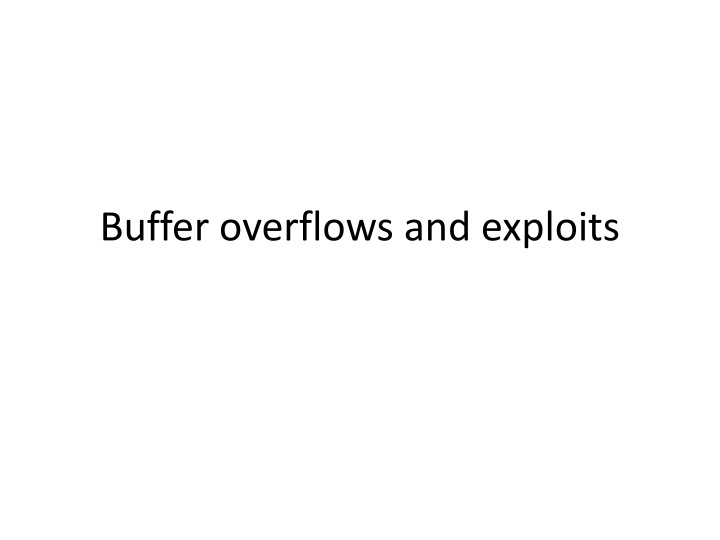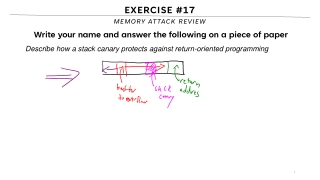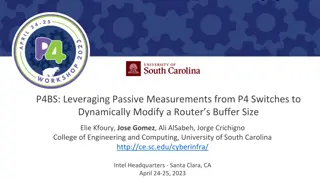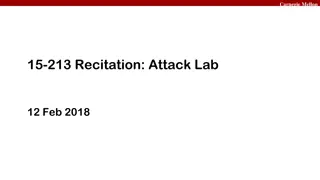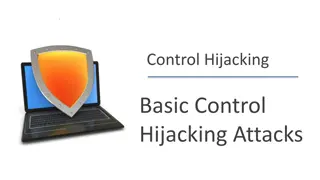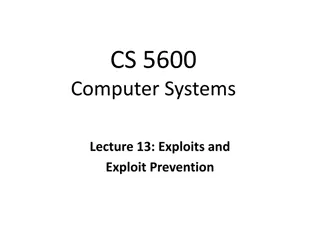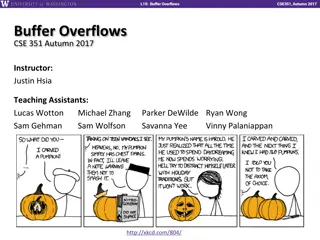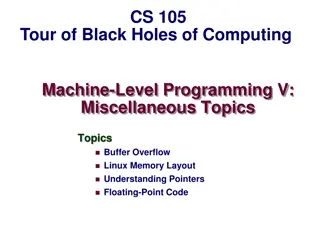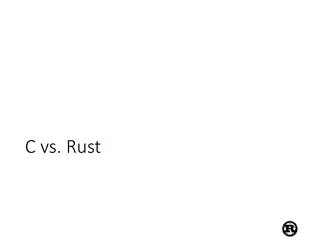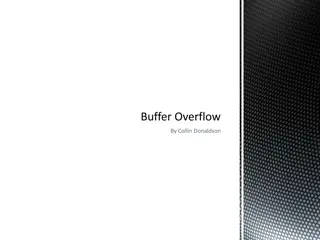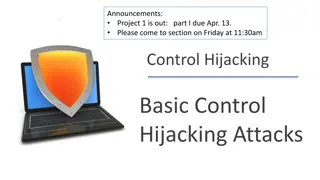Buffer Overflows and Exploits in C Programs
Explore the concepts of buffer overflows and exploits in C programming, covering memory layout, program details, and examples of stack smashing and implicit casting bugs. Learn how attackers manipulate code sequences and take control through vulnerabilities like the misuse of functions like memcpy.
Download Presentation

Please find below an Image/Link to download the presentation.
The content on the website is provided AS IS for your information and personal use only. It may not be sold, licensed, or shared on other websites without obtaining consent from the author.If you encounter any issues during the download, it is possible that the publisher has removed the file from their server.
You are allowed to download the files provided on this website for personal or commercial use, subject to the condition that they are used lawfully. All files are the property of their respective owners.
The content on the website is provided AS IS for your information and personal use only. It may not be sold, licensed, or shared on other websites without obtaining consent from the author.
E N D
Presentation Transcript
C memory layout We talked about the heap and stack last time. Heap: dynamically allocated data (so grows and shrinks depending on objects created) Stack: grows and shrinks as functions are called and return On intel machines, stack grows down
C program details Details: Each stack frame has space for local function variables Stack pointer (SP) register points to current frame Instruction pointer (IP) register points to next machine instruction to execute Caller sets up the arguments on the stack Procedure call: Push current IP onto the stack (return address) Jump to beginning of function being called Compiler inserts a prologue into each function: Current value of SP onto stack Allocates stack space for local variables by decrementing SP by appropriate amount Function return: Old SP and return address retrieve, then frame popped from stack Execution then continues from the return address
Smashing the stack First attacker puts malicious code sequence somewhere in the program s address space Next, attacker provides carefully chosen sequence Last bytes are chosen to hold code s address and overwrite the saved return address When the vulnerable function returns, the CPU loads the attacker s return address, handing control over to the attacker s code Reference: Smashing the stack for fun and profit seminal and worth a read!
More complex example char buf[80]; void vulnerable() { int len = read_int_from_network(); char *p = read_string_from_network(); if (len > sizeof buf) { error("length too large, nice try!"); return; } memcpy(buf, p, len); Anything wrong here? Hint: details are in memcpy! Prototype: Void *memcpy(void *dest, const void *src, size_t n); Definition of size_t n is an unsigned int size_t
Implicit Casting bug Attacker can provide a negative length for len If won t notice anything wrong! Executes memcpy with negative 3rdarg This is implicitly cast to an unsigned int, and becomes very large positive int memcpy then copies a huge amount of memory into buf another buffer overflow. A signed/unsigned or implicit casting bug very nasty and hard to spot C compiler never warns about this type of mismatch simply automatically casts!
Buffer overflow summary Attackers can develop techniques for when: Buffer is stored on heap instead of stack Can overflow only by one bit or byte Characters written to buffer are limited (like only one case or only numeric) Many other cases . Buffer overflows appear mysterious, but are really not that hard to exploit Best defense know the details of your programming language, so that you can avoid these pitfalls
Formatting string vulnerabilities void vulnerable() { char buf[80]; if (fgets(buf, sizeof buf, stdin) == NULL) return; printf(buf); } Do you see the bug? Last line should be: printf( %s ,buf) If buf contains % chars, printf() will look for non- existent args, and may crash or core-dump trying to chase down missing pointers Actually can get even worse
More on string vulnerabilities Attacker can actually get info about function s stack frame contents if they can see that print Use string %x:%x to see the first two words of stack memory What does ( %x:%x:%s ) do? Prints first two words of stack memory Treats next stack memory word as memory address and prints everything until first /0 Where does the last word of stack memory come from? Somewhere in printf() s stack frame, or (given enough %x specifiers to go past printf() s frame) comes somewhere in vulnerable() s stack frame!
Further refinement buf is stored in vulnerable() s stack frame Attacker controls buf s contents and thus, part of vulnerable() s stack frame This is where %s gets its memory address! Attacker can then store addr in buf, then when %s reads a word from the stack to get an addr, it receives the addr they put there for it! Example exploit: \x04\x03\x02\x01:%x:%x:%x:%x:%s Attacker arranges the right number of %x s so addr is read from first word of buffer (which contains 0x01020304) Attacker can read any memory in the victim s address space! Including crypto keys, passwords, etc.
And it gets worse If the victim has a format string bug, can be even worse than this! Use obscure format specifier (%n) to write any value to any address in the victim s memory Enables attackers to mount malicious code injection attacks Introduce code anywhere into victim s memory Use format string bug to overwrite return address on stack (or a function pointer) with pointer to malicious code
Format string summary Any program with a format string bug can be exploited by an attacker These are easy to make! Look back at your own code and I bet you did some of these in 2100 Gains control of victim s system and all privileges it has on the target system Format string bugs can be just as nasty as buffer overflows
Heap exploits Every memory allocation made in C/C++ (say by calling malloc or new) is internally represented by a chunk This is metadata and the memory actually returned to the program These chunks are saved in the heap, which can grow or shrink as needed. Metadata consists of sizes and pointers to other chunks
Simple example If a program calls mallic(256), malloc(512), and malloc(1024), heap generally (originally) stored these in order. So: Meta-data of chunk created by malloc(256) The 256 bytes of memory return by malloc ----------------------------------------- Meta-data of chunk created by malloc(512) The 512 bytes of memory return by malloc ----------------------------------------- Meta-data of chunk created by malloc(1024) The 1024 bytes of memory return by malloc ----------------------------------------- Meta-data of the top chunk Key: top chunk represents remaining available memory on heap, and it is the only chunk that ever grows in size When a new memory request comes in, top chunk is split in two to form requested chunk plus new top chunk that is now smaller in size. If not enough is left, then the program requests that the OS expand the top chunk, so the heap grows.
Chunk metadata in glibc Fields in the metadata are the key to most exploits. Free chunks are stored in a doubly linked list so that each chunk as a pointer to previous and next free chunks. Goal: if a chunk is deallocated, we can combine to make larger free chunk Actually a bit more complex: each chunk size has its own linked list, so can search for one of a given size more quickly Only if no appropriate size one is free will we allocate from the top chunk
Freeing a chunk When a chunk is freed and combined with another free one next to it, it increases in size. This means it will be removed from one linked list, and new chunk is added to a new list. (Hopefully review from OS, or clear if you ve had data structures)
Vulnerability Key here is that two write operations are being done to metadata, which are simple copies of the fields in heap. We can control the value being written, and where it is being written Goal: Write an arbitrary value to an arbitrary location! Then we can overwrite function pointer of a destructor and make it our own code. Fairly technical stuff but once publicized, not necessarily hard to do!
Other examples glibc has patched this, but many similar things are still vulnerable. Example: CVS systems up to 1.11.15 contain an off by 1 attack, where an attacker can insert one additional character into the heap. This can actually be repeated, so additional M s are added Essentially, can add fake data which when updated in the heap allow the same write exploit as previously described So these are embedded in existing programs, and can be hard to catch!
Heap exploits Several common heap based exploits: The House of Prime: Requires two free's of chunks containing attacker controlled size fields, followed by a call to malloc. The House of Mind: Requires the manipulation of the program into repeatedly allocating new memory. The House of Force: Requires that we can overwrite the top chunk, that there is one malloc call with a user controllable size, and finally requires another call to malloc. The House of Spirit: One assumption is that the attacker controls a pointer given to free. Many others specified go see Malloc Maleficarum and related articles.
Heap recap/summary Attack is located in the heap, and not the stack, but otherwise principle is simple Goal isn t to target flow of execution directly rather, usually the goal is to overwrite data Again, predictable layout combined with clever tricks make an attacker quite likely to succeed, depending on the product, since many programs aren t careful with memory management
Preventing exploits Fix bugs: Audit software Automated tools: Coverity, Prefast/Prefix. Rewrite software in a type safe languange (Java, ML) Difficult for existing (legacy) code Concede overflow, but prevent code execution Add runtime code to detect overflows exploits Halt process when overflow exploit detected StackGuard, LibSafe,
Non-executable memory Prevent attack code execution by marking stack and heap as non-executable NX-bit on AMD Athlon 64, XD-bit on Intel P4 Prescott NX bit in every Page Table Entry (PTE) Deployment: Linux (via PaX project); OpenBSD Windows: since XP SP2 (DEP) Visual Studio: /NXCompat[:NO] Limitations: Some apps need executable heap (e.g. JITs). Does not defend against `Return Oriented Programming exploits
Example: DEP In windows:
Return oriented programming Control hijacking without executing code Idea: overwrite the return address rather than try to execute code in stack or heap Can reroute to /bin/sh, for example, instead of continuing in the current execution library Much harder to defend against But does require that the attacker know where to return to!
Response: randomize! ASLR: (Address Space Layout Randomization) Map shared libraries to rand location in process memory Attacker cannot jump directly to exec function Deployment: (/DynamicBase in visual studio) Windows Vista: 8 bits of randomness for DLLs: aligned to 64K page in a 16MB region Windows 8: 24 bits of randomness on 64-bit processors Other randomization methods: Sys-call randomization: randomize sys-call id s Instruction Set Randomization (ISR) 256 choices
ASLR Example Booting twice loads libraries into different locations: Note: everything in process memory must be randomized stack, heap, shared libs, image Win 8 Force ASLR: ensures all loaded modules use ASLR
Another attack: JIT spraying Force JavaScript JIT to fill heap with executable shellcode Then point SFP anywhere in spray area NOP slide shellcode execute enabled execute enabled heap execute enabled execute enabled vtable
Run time defenses Many run-time checking techniques we only discuss methods relevant to overflow protection Solution 1: StackGuard Run time tests for stack integrity. Embed canaries in stack frames and verify their integrity prior to function return.
Canary types Random canary: Random string chosen at program startup. Insert canary string into every stack frame. Verify canary before returning from function. Exit program if canary changed. Turns potential exploit into DoS. To corrupt, attacker must learn current random string. Terminator canary: Canary = {0, newline, linefeed, EOF} String functions will not copy beyond terminator. Attacker cannot use string functions to corrupt stack
More on Stackguard StackGuard implemented as a GCC patch Program must be recompiled Some performance effects: 8% for Apache Note: Canaries do not provide full protection Some stack smashing attacks leave canaries unchanged Heap protection: PointGuard Protects function pointers and setjmp buffers by encrypting them: e.g. XOR with random cookie Less effective, more noticeable performance effects
StackGuard enhancements: ProPolice ProPolice (IBM) - gcc 3.4.1. (-fstack-protector) Rearrange stack layout to prevent ptr overflow. args ret addr String Growth Protects pointer args and local pointers from a buffer overflow SFP CANARY local string buffers Stack Growth pointers, but no arrays local non-buffer variables copy of pointer args
MS Visual Studio /GS [since 2003] Compiler /GS option: Combination of ProPolice and Random canary. If cookie mismatch, default behavior is to call _exit(3) Function prolog: sub esp, 8 // allocate 8 bytes for cookie mov eax, DWORD PTR ___security_cookie xor eax, esp // xor cookie with current esp mov DWORD PTR [esp+8], eax // save in stack Function epilog: mov ecx, DWORD PTR [esp+8] xor ecx, esp call @__security_check_cookie@4 add esp, 8 Enhanced /GS in Visual Studio 2010: /GS protection added to all functions, unless can be proven unnecessary
/GS stack frame args String Growth ret addr SFP Canary protects ret-addr and exception handler frame exception handlers CANARY local string buffers Stack Growth pointers, but no arrays local non-buffer variables copy of pointer args
Evading /GS with exception handlers When exception is thrown, dispatcher walks up exception list until handler is found (else use default handler) After overflow: handler points to attacker s code exception triggered control hijack Main point: exception is triggered before canary is checked 0xffffffff SEH frame SEH frame high mem ptr to next handler buf next next handler attack code next handler
Defenses: /SAFESEH: linker flag Linker produces a binary with a table of safe exception handlers System will not jump to exception handler not on list /SEHOP: platform defense (since win vista SP1) Observation: SEH attacks typically corrupt the next entry in SEH list. SEHOP: add a dummy record at top of SEH list When exception occurs, dispatcher walks up list and verifies dummy record is there. If not, terminates process.
Summary: canaries are not everything Canaries are an important defense tool, but do not prevent all control hijacking attacks: Heap-based attacks still possible Integer overflow attacks still possible /GS by itself does not prevent Exception Handling attacks (also need SAFESEH and SEHOP)
What if cant recompile: Libsafe Solution 2: Libsafe (Avaya Labs) Dynamically loaded library (no need to recompile app.) Intercepts calls to strcpy (dest, src) Validates sufficient space in current stack frame: |frame-pointer dest| > strlen(src) If so, does strcpy. Otherwise, terminates application
How robust is Libsafe? high memory low src buf sfp ret-addr sfp ret-addr dest memory main Libsafe strcpy strcpy() can overwrite a pointer between buf and sfp.
More methods StackShield At function prologue, copy return address RET and SFP to safe location (beginning of data segment) Upon return, check that RET and SFP is equal to copy. Implemented as assembler file processor (GCC) Control Flow Integrity (CFI) A combination of static and dynamic checking Statically determine program control flow Dynamically enforce control flow integrity
